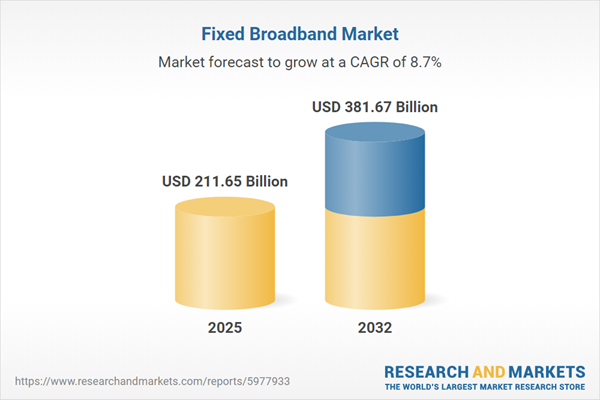Speak directly to the analyst to clarify any post sales queries you may have.
The fixed broadband market is transforming rapidly as it becomes an indispensable pillar for business continuity, digital transformation, and advanced connectivity worldwide. Senior executives must navigate dynamic trends, evolving customer expectations, and shifting regulatory frameworks to maintain competitiveness and unlock new growth avenues.
Fixed Broadband Market Snapshot
The Fixed Broadband Market grew from USD 195.30 billion in 2024 to USD 211.65 billion in 2025. It is expected to continue growing at a CAGR of 8.73%, reaching USD 381.67 billion by 2032. Investment is accelerating across infrastructure, technology, and bundled offerings as organizations race to meet rising expectations for reliability, speed, and coverage in both established and emerging economies.
Scope & Segmentation Analysis
- Connection Types: Cable Internet, Digital Subscriber Line (DSL), Fiber Optics
- Speed Ranges: 101 Mbps to 300 Mbps, 25 Mbps to 100 Mbps, Less than 25 Mbps, More than 300 Mbps
- Technologies: Fiber to the Building/Basement, Fiber to the Home, Fiber to the Node
- End Users: Large Enterprises, Small & Medium Enterprises, Educational Institutions, Government & Public Sector, Residential Users
- Regions: Americas (North America: United States, Canada, Mexico; Latin America: Brazil, Argentina, Chile, Colombia, Peru), Europe, Middle East & Africa (Europe: United Kingdom, Germany, France, Russia, Italy, Spain, Netherlands, Sweden, Poland, Switzerland; Middle East: United Arab Emirates, Saudi Arabia, Qatar, Turkey, Israel; Africa: South Africa, Nigeria, Egypt, Kenya), Asia-Pacific (China, India, Japan, Australia, South Korea, Indonesia, Thailand, Malaysia, Singapore, Taiwan)
- Company Coverage: América Móvil, AT&T Inc., BCE Inc., Bharti Airtel Limited, British Telecommunications plc, Charter Communications Inc., China Telecom Corporation Limited, China Unicom (Hong Kong) Limited, Cisco Systems Inc., Comcast Corporation, Deutsche Telekom AG, Huawei Technologies Co., Illiad S.A., Koninklijke KPN N.V., Liberty Global plc, Lynham Networks Pty Ltd, Nippon Telegraph and Telephone Corporation, Nokia Corporation, Orange S.A., PLDT Inc., Reliance Jio Infocomm Ltd., Rogers Communications Inc., Saudi Telecom Company, SK Telecom Co., Ltd., Swisscom AG, Telefonica S.A., Telenor ASA, Telstra Group Limited, TELUS Corporation, TPG Telecom Limited, Verizon Communications Inc., Vodafone Group PLC
Key Takeaways for Senior Decision-Makers
- Fiber and virtualization technologies are changing service delivery models, improving scalability, and allowing for agile network management.
- Collaboration among operators, municipal authorities, and vendors is essential to streamline infrastructure expansion and speed up permitting processes.
- Strategic partnerships and bundled services are supporting value creation and opening new revenue streams across the fixed broadband ecosystem.
- Market segmentation enables tailored service design for large enterprises, SMEs, public sector, and residential customers, each with distinct connectivity requirements.
- Regional strategies must account for varying regulatory frameworks, access to capital, and unique user behaviors across global markets.
Tariff Impact and Market Response
Recent United States tariff measures on network equipment and fiber components have led to higher procurement expenses. To mitigate supply chain risks, many service providers now diversify suppliers, pursue bulk purchasing, and reevaluate investment timelines. Industry-wide collaboration with government agencies and the adoption of localized sourcing strategies have partially offset cost pressures and deployment slowdowns in key urban and commercial areas.
Methodology & Data Sources
This analysis draws on structured executive interviews, regulatory filings, technical reports, and peer-reviewed journals. Multi-source triangulation and quantitative scenario modeling ensure robust, validated insights into fixed broadband developments, supplier strategies, and emerging technologies.
Why This Report Matters
- Enables C-suite leaders to anticipate technology transitions and adapt network investment priorities with confidence, informed by segmented and regional market intelligence.
- Supports procurement and operational planning by clarifying the impact of regulatory measures, supply chain risks, and evolving consumer demand on strategic forecasts.
- Delivers actionable recommendations to respond effectively to policy shifts and evolving customer needs.
Conclusion
The fixed broadband market is advancing through innovation and collaborative strategies. Informed decision-making and flexible approaches can support growth, resilience, and differentiation in a complex and dynamic sector.
Additional Product Information:
- Purchase of this report includes 1 year online access with quarterly updates.
- This report can be updated on request. Please contact our Customer Experience team using the Ask a Question widget on our website.
Table of Contents
3. Executive Summary
4. Market Overview
7. Cumulative Impact of Artificial Intelligence 2025
Companies Mentioned
The companies profiled in this Fixed Broadband market report include:- América Móvil, S.A.B. de C.V.
- AT&T Inc.
- BCE Inc.
- Bharti Airtel Limited
- British Telecommunications plc
- Charter Communications, Inc.
- China Telecom Corporation Limited
- China Unicom (Hong Kong) Limited
- Cisco Systems, Inc.
- Comcast Corporation
- Deutsche Telekom AG
- Huawei Technologies Co., Ltd.
- Illiad S.A.
- Koninklijke KPN N.V.
- Liberty Global plc
- Lynham Networks Pty Ltd
- Nippon Telegraph and Telephone Corporation
- Nokia Corporation
- Orange S.A.
- PLDT Inc.
- Reliance Jio Infocomm. Ltd.
- Rogers Communications Inc.
- Saudi Telecom Company
- SK Telecom Co., Ltd.
- Swisscom AG
- Telefonica, S.A.
- Telenor ASA
- Telstra Group Limited
- TELUS Corporation
- TPG Telecom Limited
- Verizon Communications Inc.
- Vodafone Goup PLC
Table Information
| Report Attribute | Details |
|---|---|
| No. of Pages | 182 |
| Published | November 2025 |
| Forecast Period | 2025 - 2032 |
| Estimated Market Value ( USD | $ 211.65 Billion |
| Forecasted Market Value ( USD | $ 381.67 Billion |
| Compound Annual Growth Rate | 8.7% |
| Regions Covered | Global |
| No. of Companies Mentioned | 33 |








